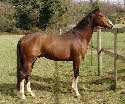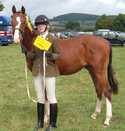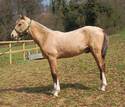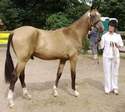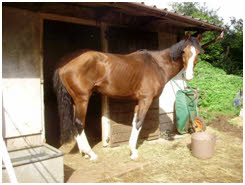|
Weds 8th September - Weds 3rd November 2010
Day 1. Evening. Sam's off his food.
He trashed his feed this morning, so I put his bucket in the
hay manger to keep it steady. When I return to remove it he
hasn't eaten any. Instead he looks colicky; he's tucked up
and tense, stamping around, clearly uncomfortable. But it
passes quickly, and he settles. His pulse and temperature
are normal. I look in at bedtime, and again in the night,
and he's standing quietly, eating hay. Or so I think.
Day 2. He's eaten his breakfast, but is
not right. Has he eaten something? My first fear is an early
fall of acorns, but there are very few on the ground. Into
town to get some bran. I'm giving a talk today, booked more
than a year ago, and can't cancel other than for an emergency.
So I can't get the vet until tomorrow. Meanwhile I make a
barley mash, which he rejects in favour of "normal"
food. Xan mops it up happily.
Day 3. The vet checks him all over, gives
him a painkiller and takes blood and faeces samples. He rings
with the results: slight anaemia, slightly low white blood
cell count - means there's no infection - kidney function
fine, so no acorn poisoning; a couple of liver enzymes elevated
but albumen high - no ragwort poisoning. He gives me a powerful
tonic - Haemolytan - for the anaemia, and suggests another
blood test in a week or two.
Day 4. Sam's more tucked up than ever, and
trembling. He has also been sweating up intermittently, though
I never actually catch him wet. Another bran mash goes on
the muck-heap; we compromise on a good helping of bran in
his Alfa-A and beet pulp, with a sprinkling of barley on top,
in a number of small feeds throughout the day. His droppings
are down to one a day. I begin to realise he's not actually
eating any hay - just chewing it interminably, then dropping
it into his bed and burying it.
Day 5 - 6. He's dropping weight fast, and
barely drinking. But the four feeds a day are going down,
and the bran is softening his droppings - 2 to 3 a day. His
pulse and temperature remain steady, and he looks alert. Surely
whatever this is will soon pass. On day 7 I run out of Alfa-A,
and have to substitute Hi-Fi. It's only a small proportion
of the feed, but he won't eat it.
Day 7. Same at breakfast. Into the feed
merchant first thing, and thankfully home with the Alfa-A.
But now he won't eat that either. Clearing a space in the
feed, he endlesly licks the bottom of the bucket, possibly
trying to stimulate salivation.The only thing which he will
eat is grass, and I am taking him daily into the garden to
graze. At supper time I make a great to-do banging bowls and
bins, until Xan is screaming for his feed and Sam is joining
in. I give him two variations on his feed, but he won't touch
either. Now I am really, really worried.
Day 8. No breakfast. He rejects his feed
throughout the day, and will only eat cut grass. A sick dread
is growing on me, and I go to the internet and look up Grass
Sickness. Miserably I tick off the symptoms: the rapid weight
loss, the refusal to eat, colicky symptoms, sweating, the
muscle tremors, the tucked-up ribcage, the "elephant-on-a-tub"
stance, with all four feet tucked closely together under him,
the constant snuffling - caused by a dry nasal inflammation.
Two symptoms, though, are absent. High heart rate - his pulse
is steady at or under 40 - and depression. He is alert and
interested, even when his discomfort is at its worst and he
stands with his feet tucked under performing a dreadful slow
piaffe.
Keeping him eating is paramount. I take him
to graze in a neighbour's field, and he eats hungrily for
an hour. But he must eat more than grass. The advice is to
give a variety of food, so I mix up various rations with alfalfa
chaff, boiled barley, plain barley, bran, beet pulp and eggs.
He won't touch any of them. Raiding the fridge, I find three
organic carrots, which he wolfs down - Sam and carrots have
always had an extraordinary affinity.
Day 9. The hunt is on for carrots. None
of my usual feed merchants have any yet - "end of the
month" - so into town to clean out Morrison's, getting
a couple of cabbages for good measure. Sam adds them to his
grass diet with approval. From now on he eats 6 lbs a day.
This willingness to eat, if I can only find the right things,
is a good sign. Chopped carrots, though, don't tempt him to
eat any of his other food. I realise that he simply can't
smell them, due to the nasal inflammation. It is obvious that
he will only eat food he recognises by its feel on his lips.
Nothing unfamiliar, therefore, is any use. I arrange a delivery
of haylage for the next day. Maybe this will be softer, more
tempting than soaked hay. Too late to catch my vet - his day
off - but I write an A4 list of questions.
Day 10. Haylage arrives. No good. Back to
my neighbour to make an arrangement to take Sam daily for
grazing. Again, he eats well. Spending every available minute
on the Equine Grass Sickness websites, I find something which
knocks my cautious rise in spirits back on to the floor. "Horses
which eat only grass and succulents," say two of the
most authoritative figures, "invariably do not survive."
You have to get highly nutritional food into them. I manage
to speak to my vet, and am further depressed. There is no
treatment, and he warns me that the outlook is very poor.
"What about the Horse Hospital at Tewkesbury," I
ask, having read about the success rate of horses taken into
the Royal Dick in Edinburgh, the world authority on EGS. Don't
even think about it, was the answer. "You'd be looking
at at least six weeks."
Day 11. I have to find something this horse
will eat. Managing to track down some large nets of carrots
at Lock's Garage near Hereford, I continue on impulse to the
Old Forge Tack Shop at Wormbridge. They have an impressive
range of feeds, and allow me to spend some time in their store
reading labels. I settle for Bailey's No. 10 Racehorse Mix,
which has a colossal energy per kilo ratio. It's also molassed
- something I normally avoid like the plague, but which Sam
likes, so it may help him to recognise the taste. Looking
for a pre/probiotic, I pick out NAF Pink Powder, highly recommended
by the lady who runs the store. She has also had the care
of a horse with a similar condition, and gives me a lot of
helpful advice. She suggests I rug him, although the weather
is still warm, to conserve every available bit of energy.
For good measure, I buy a drum of molasses, which later goes
down like a lead balloon.
Back home, I lay 1 lb of the Racehorse Mix
reverently under Sam's nose with all my fingers and toes crossed.
Luckily it is small and fine, even the oats whole, more like
birdseed that the usual coarse mixes. He snuffles round it,
then tries a bit and decides he likes it. It slips down easily,
and he eats the lot. For afters he gets some Pink Powder,
mixed with cornflour paste and syringed into his mouth - same
as I'm now doing with the vet's Haemolytan since he stopped
taking it in his feed. By the end of the day he's eaten 3
lbs of the mix. That night, I put a light rug on him - only
to find at bedtime that he's sweated up terribly under it.
I replace it with the lightest of coolers and check him in
the night to find he's OK.
Day 12. It's raining, but he must go out
and stretch his legs, so I put my lightest turnout rug on
him. He comes in an hour later soaked with sweat. He's hardly
drinking, and I'm getting seriously worried about dehydration.
From now on he wears nothing but the lightest cooler on the
colder nights, and if it rains, he stays in. By now he looks
quite dreadful - it's hard to believe a horse can lose so
much weight in under two weeks - but the Racehorse Mix continues
to go down.
Day 13. Now he's eating something, my next
worry is the other end. What if I overload a constipated horse
with a damaged gut and end up getting impaction? Back to the
vet. What about tubing a laxative into him? Not a good idea.
But he gives me a syringe with a laxative to give as an enema,
a pleasure Sam receives when I get home. And that day, on
coming back from grazing, he takes a long drink - thirty swallows
- the first time I've really seen him drink properly. I manage
to catch the right time to ring the Grass Sickness helpline,
and get many answers from a kind, experienced and encouraging
lady.
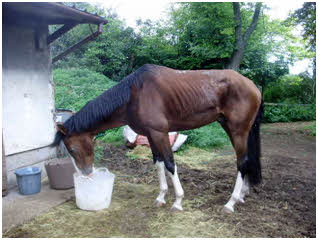 |
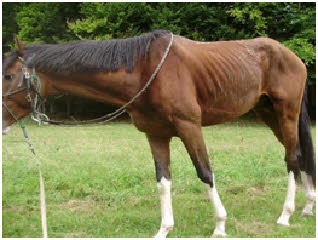 |
Two
classic signs of grass sickness - tucked-up ribcage
and "elephant-on-a-tub" stance - as well as
sweating up and weight loss. |
|
| Another
day's rehydration shows
a rapid improvement |
Day 14. This horse is looking better. For the
first time, I begin to believe that we might win. I'm now managing
to sneak some bran into his birdseed, and the enema has done
its stuff. Again, he drinks long and deep on coming back from
grazing. A pinch test shows he's not dehydrated - should have
thought of that last week. I am learning ways to stimulate him
to defaecate - take him to his own stud pile and, if that fails,
to Xan's. Depositing on another horse's stud pile is the stallion
equivalent of peeing up another dog's lamp-post, and he busts
a gut (almost literally) to oblige.
Day 15 - 21. Slow progress. By the end of the week
he's eating 6 lbs Racehorse Mix, 2 lbs bran, 6 lbs carrots,
a small helping of sugar beet and as much grass as I can cut,
in addition to his daily grazing. But that's his limit; he
doesn't eat more, and when I try to take him to graze too
soon after a feed, he quickly gets gastric reflux. He still
refuses alfalfa chaff, and the beet is his only bulk food
apart from the grass. He tries to eat haylage, but it makes
him choke horribly. He gets terribly angry with it and strews
it all round the stable, burying it in the bed then digging
it up again. The muscle tremors have stopped, as has the awful
snuffling, and most of the tightness round his bottom rib
has relaxed, though he still tucks up again after eating.
It's impossible that he's actually gained true weight on these
bare maintenance rations, and I begin to understand how much
of the rapid emaciation of EGS is caused by dehydration, as
well as the tight ribcage. The Pink Powder now goes in the
cut grass - a big help, as he hates the syringe. He is up
to three dung-piles a day - progress! I'd never thought I'd
be so keen to shovel horse-s**t.
I worry about continuing to turn him out
on the same field. But I have nowhere else secure for a stallion,
and the EGS helpline tell me not to worry. I'm looking for
charcoal, a powerful mopper-up of toxins, and a flick through
some catalogues shows that "Happy Tummy" charcoal
is produced just down the road at Monmouth. A quick trip,
a helpful discussion with Paula of Fine Fettle Feed, and yet
another tub joins the line-up of additives. Xan gets a dose
as well - from now on, it will be de rigueur for horses on
this field. Just in case.
Day 22 - 28. Pretty much a plateau. His
intake is steady and I'm pretty sure than, unless there are
hidden time bombs like kidney damage from the dehydration,
he will survive. He's eating a little more beet, and, with
the carrots, his total intake is 15 - 16 lbs food a day plus
the grass. I've been able to put away the syringe and put
the Haemolytan into the feed - a relief for us both.
He gave a little skip recently on the way
down to the grazing field.
Day 32. Today he ate some boiled alfalfa
chaff with what seems like gusto. A step forward? Desperately
needed, as he's getting fussy over cut grass. It's now October,
the grass is coarser, and I have to pick dead leaves out of
it. Two or three times lately it's been hoovered up by a grateful
Xan. The secret is to find clover - which the websites tell
you to avoid...
Day 33. In the last 24 hours Sam's eaten
about 2 lbs Alfa-A, produced 5 dung-piles - and booked a mare
into his diary for next year!
I suspect he could now manage some haylage
if I suspended grass deliveries, but don't dare to call his
bluff just yet. "Have you thought of peeling some grapes
for him?" says Jacquie.
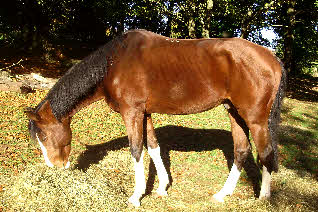 |
Week 8. Sam is now eating 6 lbs
boiled Alfa-A per day. Over the week I've reduced the
hard food from 6 lbs Racehorse Mix and Allen & Page
Weight Gain down to 4½ lbs, and the number of
feeds to 3. He began to eat some haylage a week ago,
and for the last three or four days has emptied his
manger of gradually increasing amounts. At last I'm
released from the chore of grass-cutting, and the grazing
arrangement has expired without the need to renew. |
He still dribbles quite a lot while drinking,
although you can watch the water go down his throat rapidly.
Yesterday he rolled for the first time. Although
from the start he has lain down securely in his stable, he
hasn't until now dared to go down even momentarily in the
open.
He is now off the sick list, though still fragile. He has
been extraordinarily lucky in that this was obviously only
a mild case of a devastating illness; but he has made his
own luck too by not admitting defeat.
Sam's page.
|


